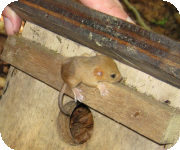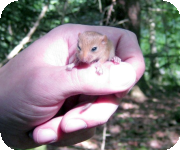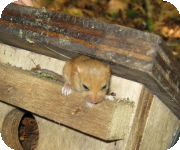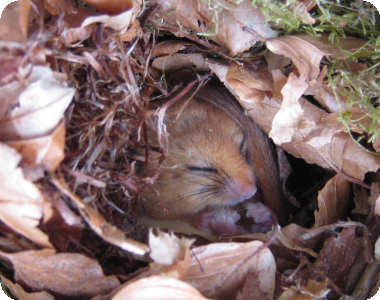Dormice
In the United Kingdom there are three species of dormice. In addition to our native species the common or hazel dormouse, (Muscardinus avellanarius), parts of England also play host to the fat or 'edible' dormouse and the garden dormouse. Hazel dormice are a European protected species.
Whilst dormice are rodents they share little in common with true mice, preferring to live in woodlands and mature hedgerows. Dormice can be quite long lived, up to five years in exceptional circumstances. Unlike true mice, dormice have fur on the insides of their ears and on their tails, and this is essential to animal that needs to save heat, particularly in hibernation. This ability to hibernate through harsh winter weather results in the hazel dormouse being known as the seven sleeper in some parts of Europe, as they literally do seem to disappear for months during the winter.
The hazel dormouse has suffered a significant decline in the last century and in 1981 they, and the woods and hedges they live in, were given protection under the provisions of the Wildlife and Countryside Act 1981 (as amended). Further protection is provided by the Conservation of Habitats and Species Regulations 2017 and the Countryside and Rights of Way Act 2000.
For over two decades we have been working to conserve dormice and their habitats. We have unrivalled experience in surveying for dormice, using hazel nut searches, nest tubes and trapping to assess presence of absence. We can advise you on dormouse mitigation measures and no matter how large or small the project, our licenced operatives can assist you where dormice are involved.
How we can help:
- Presence/absence or any other type of survey
- European protected species licence applications
- Expert witness services
- Habitat surveys
- Habitat management advice
- Mitigation schemes
- Nest box and monitoring projects
- Nest tube surveys
- Research projects
- Training courses
We offer Dormice surveys in the following areas:
Brecon Beacons, Powys, Cardiff, Monmouthshire, Swansea, Herefordshire, Merthyr Tydfil, Newport, Carmarthenshire, Bridgend, Neath Port Talbot, South Wales, Ceredigion, Bristol, Vale of Glamorgan, Somerset, Caerphilly, Torfaen, Rhondda Cynon Taff, Pembrokeshire, Gloucestershire, Worcestershire, Shropshire, Blaenau Gwent, Forest of Dean, Devon and Gower.




Did you know?
Did you know that dormice leave distinct tooth marks when opening nuts, giving the surveyor a clue as to their presence in a woodland or hedgerow?